Triceps Tendonitis: Physiotherapy Treatment
Table of Contents
INTRODUCTION
Triceps Tendonitis also known as Weightlifter’s elbow is the rarest tendonitis of the elbow, is an inflammation of the triceps tendon can cause significant discomfort and make many daily activities challenging. Tendonitis is also called tendinitis.
The muscle of the back of the arm is called triceps brachii. triceps passes behind the shoulder joint and ends at the back of the forearm after crossing the back surface of the elbow. During its contraction, tension passes through its tendon. When this tendency is increase or repeated many times then the tendon is injured. injury is followed by degeneration and inflammation This happens traumatically after a great deal of strain has been exerted on the tendon or by gradual minor injuries due to overuse. Examples: hammering, throwing a baseball, or doing bench presses.
Repeated strain on a tendon can cause tiny micro-tears in the tissue, As the number of tears increases, they can cause pain from inflammation and weaken the tendon also cause larger tears in the tissue.
Triceps tendonitis can also occur with shoulder and elbow joints that have caused damage to the area, such as arthritis, muscle tears, or dislocation. Triceps tendinitis can usually treated with RICE [Rest,Ice,Compression And Elevation]. Sometimes physiotherapy treatment is required to prevent further damage of the tissue with the help of proper stretching and exercise.
RELEVANT ANATOMY :
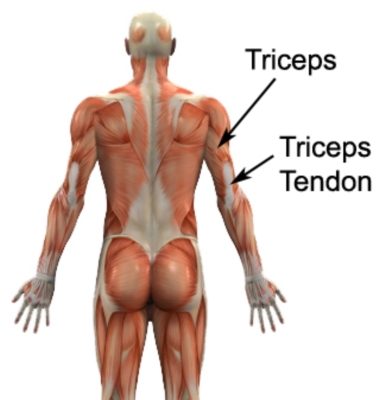
The triceps brachii muscle derives from a tripartite and it’s a three headed muscle which consist of medial, lateral, and long heads. originating from at several points along the arm, including right below the shoulder blade, the upper arm bone, and extending to the forearm. The origin of the Medial head is at the dorsal humerus, inferior to the radial groove, and connecting to the intermuscular septum.
The lateral head originated from the dorsal humerus, superior to the radial groove And The origin of the long head is from the infra-glenoid tubercle of the scapula Also it’s contributes to the extension and adduction of the arm at the shoulder joint.Furthermore, The three heads combine to form a single tendon which inserted on the olecranon of the ulna. The function of the triceps brachii is extension of the forearm at the elbow joint. Additionally,The muscle is supplied by the deep brachial artery.
PATHOPHYSIOLOGY:
Tendonitits of the triceps occurs most often in the osteo-tendon joint of the tendon in the olecranon sometimes it can also seen in the tendon itself or in the myotendinous joint. Systemic risk factors that weaken the tendon have been reported as metabolic syndromes, endocrine disorders such as diabetes and hypoparathyroidism. While, local factors that lead to weakening or injury of the tendon include the injection of corticosteroids, anabolic steroids, and over-training, leading to tendon disease or partial or complete rupture of the tendon.
What are the Causes of Triceps Tendonitis?
There are several causes that can lead to triceps tendonitis such as,
- Least common injury
- Mainly occur due to repetitive activity
- Occurs at any age
- Mainly affected Men compared to women. [most common in sportsmen]
- not warming up adequately, particularly before exercising or playing sports
- Not allowing enough recovery time between workouts
- using anabolic steroids include chronic or heavy steroid use and certain diseases, such as diabetes and immune system disorders, like rheumatoid arthritis.
- Having a chronic condition such as diabetes or rheumatoid arthritis
- Can also be caused by an acute injury, such as falling onto your outstretched arm
- Having poor form while attempting activity
- Having muscle weakness
- History of prior injury
- Being overweight
What are the common Symptoms of Triceps Tendonitis?
Specific symptoms and their severity depend upon the underlying condition. Symptoms commonly experienced, include:
- Pain or tenderness in the shoulder, elbow, or anywhere else when the triceps muscle extends.
- Discomfort that appears or worsens when you use the triceps muscles.
- Bulging, swelling, or redness around your elbow.
- Gradual weakening in your shoulder, elbow, or anywhere else the triceps muscle extends.
- In acute events, like work-related incidents, sports injuries, or automobile accidents, you may hear a popping sound that indicates tendon damage.
- In moderate to severe cases, your arm’s movability might be limited.
- The pain is exacerbated with forced extension against resistance.
- achiness in the area of your triceps, shoulder, or elbow
- a limited range of motion in your arm
- a bulge or area of swelling on the back of your upper arm, near your elbow
- weakness in or around your triceps, elbow, or shoulder
- Snapping sounds or sensations in the shoulder or elbow
DIFFERENTIAL DIAGNOSIS:
- Lateral epicondylitis
- Medial epicondylitis
- Posterior elbow impingement
- Elbow arthritis
- Olecranon bursitis
- Synovial plica syndrome
- Snapping triceps
PHYSICAL EXAMINATION
To diagnose triceps tendonitis, your doctor may press on the area where the tendons attach to the elbow or triceps to see if they can feel any hardness or swelling. Your doctor may also ask you to move your arm or elbow to assess your[ROM] range of motion. You may also be asked to perform simple shoulder or elbow exercises that will help your doctor figure out how strong your triceps, shoulder, and elbow are.
Further investigations such as an ultrasound, X-ray, CT scan or MRI scan may be required to assist with diagnosis and assess the severity of the condition.
MEDICAL MANAGEMENT:
NSAIDS [non steroidal anti- inflammatory drugs] eg. Ibuprofen should be taken regularly for a week for pain and to reduce inflammation.
In mild to moderate cases, the first line therapy known as R.I.C.E. treatment can be used:
Rest – You should rest the injured tendon as much as possible. This means avoiding all movement whenever applicable. Engaging in any heavy lifting or significant exercise is strictly forbidden until noticeable improvement has occurred.
Ice – Many doctors recommend applying ice to the affected areas for at least 20 minutes several times per day. Icing reduces inflammation.
Compression – Compressing the wounded tendon with compression bandages can provide added support to the injury and keep surrounding tissues from moving frequently or unnecessarily.
Elevation – Raising your arm above your heart increases blood circulation to the damaged areas. Increased blood flow speeds up the healing process and decreases inflammation.
PHYSIOTHERAPY MANAGEMENT:

Physiotherapy management includes a period of immobilization followed by ROM and then strengthening exercises. Initial splint immobilization with the elbow in 30 degree of flexion is continued for around 4 weeks.
Following immobilization, gradual progression of elbow motion is allowed as tolerated, with the aim to achieve full ROM within 12 weeks. The final stage is to introduce exercises to increase extension strength. Full extension strength can be achieved between 6 and 9 months.
It may also recommended a variety of modalities, including taping, massage, electric stimulation, laser treatments, etc.,used to support the tendon and aid in healing by increasing blood flow to the area.
Below are a few examples of simple exercises that you can do. It’s very important to remember to talk with your doctor before doing any of these exercises, as doing certain motions too quickly after injury may worsen your condition.
Elbow bend and straighten :
- Close your hands into loose fists at your sides.
- Raise both hands up so that they’re about shoulder level.
- Slowly lower your hands, straightening your elbow until your hands are again at your sides.
- Repeat 10 to 20 times.
French stretch :
- While standing up, clasp your fingers together and raise your hands above your head.
- Keeping your hands clasped and your elbows close to your ears, lower your hands behind your head, trying to touch your upper back.
- Hold the lowered position for 15 to 20 seconds.
- Repeat 3 to 6 times.
Static triceps stretch :
- Bend your injured arm so that your elbow is at 90 degrees. In this position your hand should be in a fist with your palm facing inward.
- Use the fist of your bent arm to push down on the open palm of your other hand, tightening the triceps muscles in the back of your injured arm.
- Hold for 5 seconds.
- Repeat 10 times, tightening your triceps as much as you can without pain.
Towel resistance :
- Hold one end of a towel in each of your hands.
- Stand with your injured arm over your head while the other arm is behind your back.
- Lift your injured arm toward the ceiling while using the other hand to pull down gently on the towel.
- Hold the position for 10 seconds.
- Repeat 10 times.
French press:
- sit grasping a small weight with both hands as if it were a baseball bat .and reach towards the ceiling.
- bend your elbow ,slowly lower the wight behind your head until the wight touches your upper back.
- lift the weight up over your head and reach toward the ceiling again.
- repeat 10 to 20 times.
Palm down curl:
- stand with your hands at your side , hold a small weight palm down in the hand of your injured arm.
- keep your palm down and bend your elbow , slowly curl the weight up toward your shoulder as far as possible.
- for each repetition move your hand down to the strarting position more slowly then lift your hand up towards your shoulder.
- repeat 10 to 20 times.
Tricep kick back:
- lean forward with ther hand of your good arm resting on a table or chair for support.
- hold a weight in the hand of your injured arm.
- keep the elbow of your injured arm against your side.
- your arm should be bent at a 90 degree angle with upper arm parellel to the floor.
- move the forearm of your injured arm backward until it is stright.
- repeat 10 to 20 times.
Preventive Measure for Triceps Tendonitis :
- avoid overuse of the upper arm and elbow.
- avoid repetitive movements of the affected limb.
- use proper technique during sports and other regular activities to prevent tendonitis.
- You may also be able to prevent tendonitis by easing up on regular activities.
- Take Enough Rest in Between Activities
- Avoid Jerky movements
- Do Proper Warm Before Heavy Sports Activities
- Do Regular Stretching and Strengthening Exercises at Regular Intervals

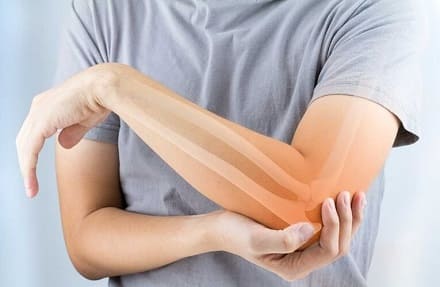
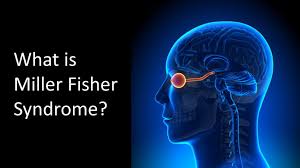

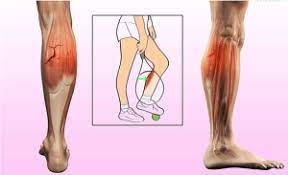

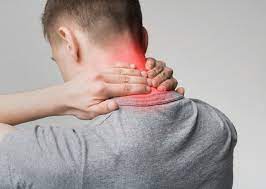
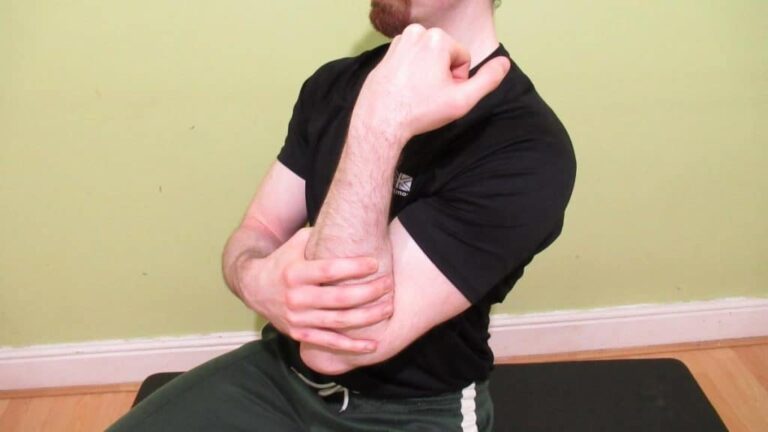
One Comment